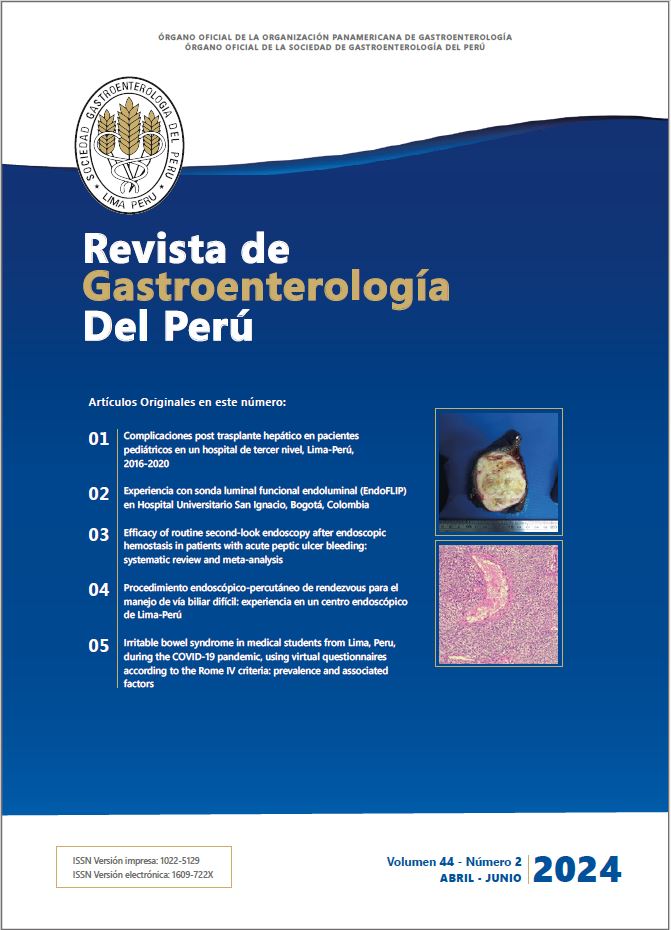Porto sinusoidal vascular disease: an unusual cause of digestive bleeding
DOI:
https://doi.org/10.47892/rgp.2024.442.1629Keywords:
Porto sinusoidal vascular diseases, Hypertension, portal, BiopsyAbstract
Portal hypertension (PHT) is defined as an increase in pressure at the level of the portal vein above 5 mmHg, the most common cause being liver cirrhosis. Among the presinusoidal intrahepatic causes of PHT with portal venular involvement, what was traditionally known as idiopathic non-cirrhotic portal hypertension (NCIH) is described, with the requirements of excluding those patients who did not present PHT, as well as those with the presence of liver cirrhosis and thrombosis. portal venous vein (PVT). Currently, the diagnostic criteria for this entity have been reconsidered, and its name, being known as porto-sinusoidal vascular disease (PSVD), also does not exclude patients with PHT or the presence of underlying liver disease. Liver biopsy continues to be the gold standard for diagnosis. The clinical manifestations are derived from PHT and the management is similar to the complications that occur in patients with liver cirrhosis. The case of a male patient is presented who presents with symptoms of digestive bleeding, with findings of esophageal varices in upper endoscopy in addition to a study of viral, autoimmune liver disease and negative deposits, with a conclusive liver biopsy of porto-sinusoidal vascular disease.
Downloads
Metrics
References
García-Tsao G. ¿Qué es la hipertensión portal no cirrótica idiopática? Clin Liver Dis (Hoboken). 2016;8(S1):S39-42. doi: 10.1002/cld.600.
De Gottardi A, Sempoux C, Berzigotti A. Porto-sinusoidal vascular disorder. J Hepatol. 2022;77(4):1124-35. doi: 10.1016/j.jhep.2022.05.033.
Jin SJ, Choi W-M. Porto-sinusoidal vascular disease: A concise updated summary of epidemiology, pathophysiology, imaging, clinical features, and treatments. Korean J Radiol. 2023;24(1):31. doi: 10.3348/kjr.2022.0668.
Turon F, Silva-Junior G, Hernandez-Gea V, García-Pagan JC. Hipertensión portal idiopática no cirrótica. Gastroenterol Hepatol. 2015;38(9):556-62. doi: 10.1016/j.gastrohep.2015.07.004.
Schouten JNL, Verheij J, Seijo S. Idiopathic non-cirrhotic portal hypertension: a review. Orphanet J Rare Dis. 2015;10(1):67. doi: 10.1186/s13023-015-0288-8.
Schouten JNL, García-Pagan JC, Valla DC, Janssen HLA. Idiopathic noncirrhotic portal hypertension. Hepatology. 2011;54(3):1071-81. doi: 10.1002/hep.24422.
Siramolpiwat S, Seijo S, Miquel R, Berzigotti A, Garcia-Criado A, Darnell A, et al. Idiopathic portal hypertension: Natural history and long-term outcome. Hepatology. 2014 Jun;59(6):2276-85. doi: 10.1002/hep.26904.
Krasinskas AM, Eghtesad B, Kamath PS, Demetris AJ, Abraham SC. Liver transplantation for severe intrahepatic noncirrhotic portal hypertension. Liver Transpl. 2005;11(6):627-34. doi: 10.1002/lt.20431.
Giudicelli H, Rautou P-E, Paradis V, Bedossa P, Goria O, Lambert V, et al. Porto-sinusoidal vascular disease. Vascular liver diseases: Position papers from the francophone network for vascular liver diseases, the French Association for the Study of the Liver (AFEF), and ERN-rare liver. Clin Res Hepatol Gastroenterol. 2020;44(4):447-51. doi: 10.1016/j.clinre.2020.03.005.
Guido M, Sarcognato S, Sacchi D, Colloredo G. Pathology of idiopathic non-cirrhotic portal hypertension. Virchows Arch. 2018;473(1):23-31. doi: 10.1007/s00428-018-2355-8.
Robert D, Odze JRG. Patología Quirúrgica del Tracto Gastrointestinal, Hígado, Tracto Biliar y Páncreas. Tercera edición. Amolca; 2017.
De Gottardi A, Rautou P-E, Schouten J, Rubbia-Brandt L, Leebeek F, Trebicka J, et al. Porto-sinusoidal vascular disease: proposal and description of a novel entity. Lancet Gastroenterol Hepatol. 2019;4(5):399-411. doi: 10.1016/s2468-1253(19)30047-0.
Downloads
Published
How to Cite
Issue
Section
License
Copyright (c) 2024 Stalin Yance, Pedro Montes, Fernando Arevalo

This work is licensed under a Creative Commons Attribution 4.0 International License.
Revista de Gastroenterología del Perú by Sociedad Peruana de Gastroenterología del Perú is licensed under a Licencia Creative Commons Atribución 4.0 Internacional..
Aquellos autores/as que tengan publicaciones con esta revista, aceptan los términos siguientes:
- Los autores/as conservarán sus derechos de autor y garantizarán a la revista el derecho de primera publicación de su obra, el cuál estará simultáneamente sujeto a la Licencia de reconocimiento de Creative Commons que permite a terceros compartir la obra siempre que se indique su autor y su primera publicación esta revista.
- Los autores/as podrán adoptar otros acuerdos de licencia no exclusiva de distribución de la versión de la obra publicada (p. ej.: depositarla en un archivo telemático institucional o publicarla en un volumen monográfico) siempre que se indique la publicación inicial en esta revista.
- Se permite y recomienda a los autores/as difundir su obra a través de Internet (p. ej.: en archivos telemáticos institucionales o en su página web) antes y durante el proceso de envío, lo cual puede producir intercambios interesantes y aumentar las citas de la obra publicada. (Véase El efecto del acceso abierto).

















 2022
2022 